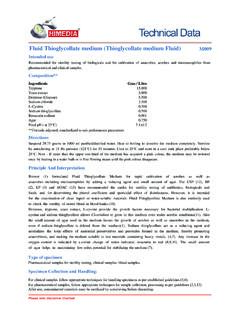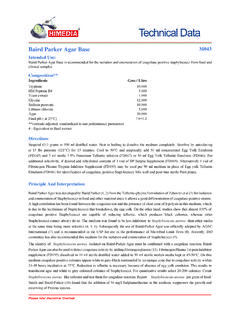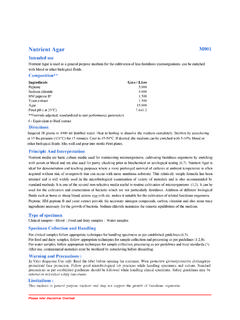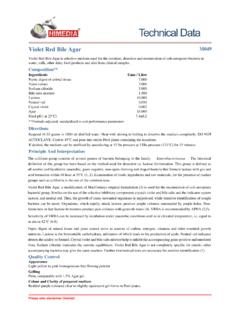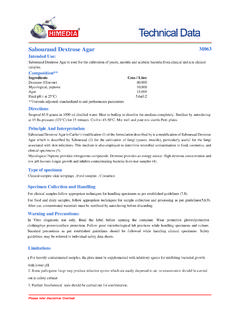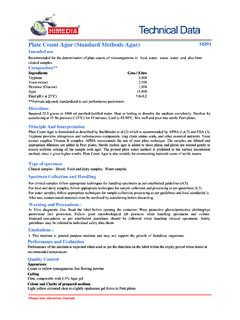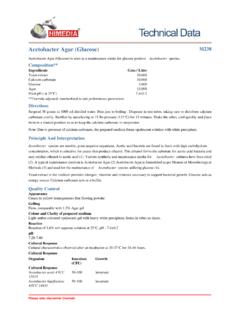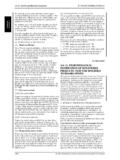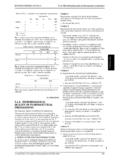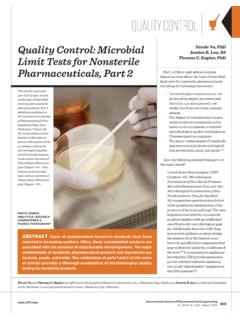Transcription of MacConkey Sorbitol Agar (Sorbitol Agar) - …
1 Please refer disclaimer Sorbitol agar ( Sorbitol Agar) M298 Intended Use:Recommended for isolation and identification of enteropathogenic Escherichia coli strains associated with infant **IngredientsGms / salts pH ( at 25 C) **Formula adjusted, standardized to suit performance parametersDirectionsSuspend grams in 1000 ml purified / distilled water. Heat to boiling to dissolve the medium completely. Sterilize by autoclaving at 15 lbs pressure (121 C) for 15 minutes. AVOID OVERHEATING. Cool to 45-50 C and pour into sterile Petri platesPrinciple And InterpretationMacConkey Sorbitol agar is based on the formulation described by Rappaport and Henigh (9). This medium is recommended for isolation of enteropathogenic Escherichia coli O157: H7, which ferments lactose but does not ferment Sorbitol , hence produces colourless colonies.
2 This organism has been recognized as a cause of hemorrhagic colitis (5). O157: H7 is a human pathogen associated with hemorrhagic colitis that results from the action of a shiga-like toxin (SLT) (2,6). On standard MacConkey agar containing lactose, this strain is indistinguishable from other lactose-fermenting In MacConkey Sorbitol agar Base, lactose is replaced by Sorbitol . Unlike most strains, O157:H7 ferments Sorbitol slowly or not at all (3,8). The growth of O157:H7 on MacConkey agar with Sorbitol shows colourless colonies and most of the fecal flora ferment Sorbitol and appear pink. MacConkey agar with Sorbitol therefore permits ready recognition of O157:H7 (2,6,7).Peptone and proteose peptone supply necessary nutrients like nitrogenous and carbonaceous compounds, long chain amino acids, minerals, vitamins and trace ingredients for the growth of organisms.
3 Crystal violet and bile salt mixture present in the medium inhibit growth of gram-positive bacteria. Sodium chloride maintains osmotic equilibrium. Neutral red is an indicator. D- Sorbitol is the fermentable of specimenClinical samples- stool, Food and Dairy Collection and HandlingFor clinical samples follow appropriate techniques for handling specimens as per established guidelines (3,4). For food and dairy samples, follow appropriate techniques for sample collection and processing as per guidelines (1,10,12). After use, contaminated materials must be sterilized by autoclaving before discarding. Warning and PrecautionsIn Vitro diagnostic use. Read the label before opening the container. Wear protective gloves/protective clothing/eye protection/face protection.
4 Follow good microbiological lab practices while handling specimens and culture. Standard precautions as per established guidelines should be followed while handling clinical specimens. Safety guidelines may be referred in individual safety data LaboratoriesTechnical DataPlease refer disclaimer Sorbitol agar however should not be solely used to detect pathogenic O157: H7 strains as some non-toxic strains will also not ferment Sorbitol (8).2. Further biochemical tests must be carried out for further and EvaluationPerformance of the medium is expected when used as per the direction on the label within the expiry period when stored at recommended ControlAppearanceLight yellow to pink homogeneous free flowing powderGellingFirm, comparable with agar and Clarity of prepared mediumPurplish red coloured clear to slightly opalescent gel forms in Petri plates ReactionReaction of w/v aqueous solution at 25 C.
5 PH : ResponseCultural characteristics observed after an incubation at 35-37 C for 18-24 (CFU)RecoveryColour ofcolonySalmonella Typhi ATCC6539luxuriant50-100>=50%pinkShigella flexneri ATCC12022 (00126*)luxuriant50-100>=50%colourlessEs cherichia coli ATCC25922 (00013*)luxuriant50-100>=50%pinkEscheric hia coli serotypeO11 and O55luxuriant50-100>=50%colourlessEscheri chia coli O157:H7 NCTC 29900luxuriant50-100>=50%colourlessDispo salUser must ensure safe disposal by autoclaving and/or incineration of used or unusable preparations of this product. Follow established laboratory procedures in disposing of infectious materials and material that comes into contact with clinical sample must be decontaminated and disposed of in accordance with current laboratory techniques (3,4).
6 For Diseases Control, 1991, Morbid. Mortal, Weekly Rep 40 and Shelf LifeStore between 10-30 C in a tightly closed container and the prepared medium at 20-30 C. Use before expiry date on the label. On opening, product should be properly stored dry, after tightly capping the bottle in order to prevent lump formation due to the hygroscopic nature of the product. Improper storage of the product may lead to lump formation. Store in dry ventilated area protected from extremes of temperature and sources of ignition Seal the container tightly after use. Use before expiry date on the performance is best if used within stated expiry period. Key : *Corresponding WDCM , Clinical Microbiology Procedures Handbook. 2nd , , Pfaller, , Carroll, , Funke, G.
7 , Landry, , Richter, and Warnock., (2015)Manual of Clinical Microbiology, 11th Edition. Vol. Public Health Association, Standard Methods for the Examination of Dairy Products, 1978, 14th Ed., LaboratoriesTechnical P. R., Baron J. H., Pfaller M. A., Tenover F. C. and Yolken R. H. (Ed.), 1999, Manual of Clinical Microbiology, 7thEd. American Society for Microbiology, Washington, D. Inc., Washington, H. M. and Frank J. H., 2004, Standard Methods for the Microbiological Examination of Dairy Products, 17th Ed.,Revision : 04/ 2019In vitro diagnostic medical device CE MarkingDo not use if package is damagedCE Partner 4U ,Esdoornlaan 13, 3951 DB Maarn The Netherlands, IVDS torage temperature10 C30 CEC REPHiMedia Laboratories Pvt.
8 Limited, 23 Vadhani Industrial Estate, LBS Marg,Mumbai-86,MS,India Disclaimer :User must ensure suitability of the product(s) in their application prior to use. Products conform solely to the information contained inthis and other related HiMedia publications. The information contained in this publication is based on our research and developmentwork and is to the best of our knowledge true and accurate. HiMedia Laboratories Pvt Ltd reserves the right to make changes tospecifications and information related to the products at any time. Products are not intended for human or animal or therapeutic use butfor laboratory,diagnostic, research or further manufacturing use only, unless otherwise specified.
9 Statements contained herein should notbe considered as a warranty of any kind, expressed or implied, and no liability is accepted for infringement of any Laboratories Pvt. Ltd. : 23, Vadhani , LBS Marg, Mumbai-400086, India. Customer care No.: 022-6116 9797 Corporate office : A-516,Swastik Disha Business Park,Via Vadhani Ind. Est., LBS Marg, Mumbai-400086, India. Customer care No.: 022-6147 1919 Email: Website: Salfinger Y., and Tortorello Fifth (Ed.), 2015, Compendium of Methods for the Microbiological Examination ofFoods, 5th Ed., American Public Health Association, Washington, M. W., Gay J. M., Hancock D. D., Gay C. C., Fox L. K. and Besser T. E., 1955, J. Clin. Microbiol., 33:261613. Zadik J.
10 M., Chapman P. A. and Siddons C. A., 1993, J. Med. Microbiol., 39 F. and Henigh E., 1952, J. Clin. Pathol., 6 : M. J., Chan E. C. and Kreig M. R., 1986, Microbiology, 5th Ed., McGraw Hill Book Co., New M. A., Petric M., Lim C. et al, 1985, J. Infect. Dis.,151 S. B. and Ratnam S., 1986, J. Clin. Microbiol., 23:869.
